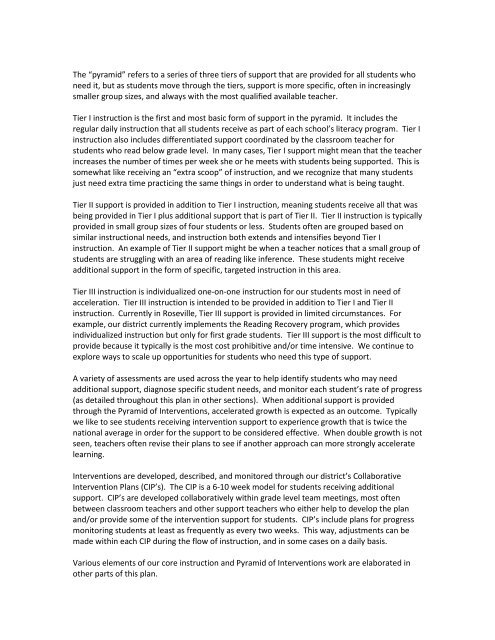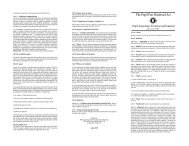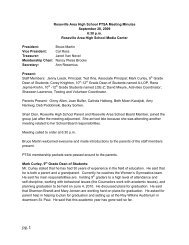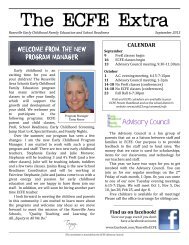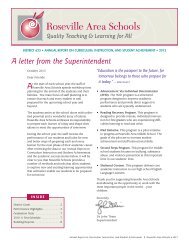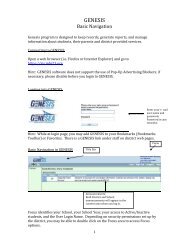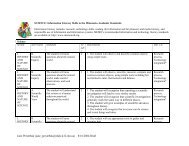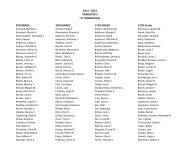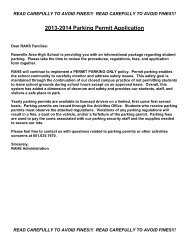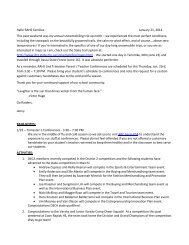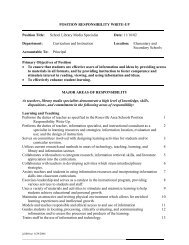Roseville Area Schools Local Literacy Plan for Reading Well by ...
Roseville Area Schools Local Literacy Plan for Reading Well by ...
Roseville Area Schools Local Literacy Plan for Reading Well by ...
Create successful ePaper yourself
Turn your PDF publications into a flip-book with our unique Google optimized e-Paper software.
The “pyramid” refers to a series of three tiers of support that are provided <strong>for</strong> all students who<br />
need it, but as students move through the tiers, support is more specific, often in increasingly<br />
smaller group sizes, and always with the most qualified available teacher.<br />
Tier I instruction is the first and most basic <strong>for</strong>m of support in the pyramid. It includes the<br />
regular daily instruction that all students receive as part of each school’s literacy program. Tier I<br />
instruction also includes differentiated support coordinated <strong>by</strong> the classroom teacher <strong>for</strong><br />
students who read below grade level. In many cases, Tier I support might mean that the teacher<br />
increases the number of times per week she or he meets with students being supported. This is<br />
somewhat like receiving an “extra scoop” of instruction, and we recognize that many students<br />
just need extra time practicing the same things in order to understand what is being taught.<br />
Tier II support is provided in addition to Tier I instruction, meaning students receive all that was<br />
being provided in Tier I plus additional support that is part of Tier II. Tier II instruction is typically<br />
provided in small group sizes of four students or less. Students often are grouped based on<br />
similar instructional needs, and instruction both extends and intensifies beyond Tier I<br />
instruction. An example of Tier II support might be when a teacher notices that a small group of<br />
students are struggling with an area of reading like inference. These students might receive<br />
additional support in the <strong>for</strong>m of specific, targeted instruction in this area.<br />
Tier III instruction is individualized one-on-one instruction <strong>for</strong> our students most in need of<br />
acceleration. Tier III instruction is intended to be provided in addition to Tier I and Tier II<br />
instruction. Currently in <strong>Roseville</strong>, Tier III support is provided in limited circumstances. For<br />
example, our district currently implements the <strong>Reading</strong> Recovery program, which provides<br />
individualized instruction but only <strong>for</strong> first grade students. Tier III support is the most difficult to<br />
provide because it typically is the most cost prohibitive and/or time intensive. We continue to<br />
explore ways to scale up opportunities <strong>for</strong> students who need this type of support.<br />
A variety of assessments are used across the year to help identify students who may need<br />
additional support, diagnose specific student needs, and monitor each student’s rate of progress<br />
(as detailed throughout this plan in other sections). When additional support is provided<br />
through the Pyramid of Interventions, accelerated growth is expected as an outcome. Typically<br />
we like to see students receiving intervention support to experience growth that is twice the<br />
national average in order <strong>for</strong> the support to be considered effective. When double growth is not<br />
seen, teachers often revise their plans to see if another approach can more strongly accelerate<br />
learning.<br />
Interventions are developed, described, and monitored through our district’s Collaborative<br />
Intervention <strong>Plan</strong>s (CIP’s). The CIP is a 6-10 week model <strong>for</strong> students receiving additional<br />
support. CIP’s are developed collaboratively within grade level team meetings, most often<br />
between classroom teachers and other support teachers who either help to develop the plan<br />
and/or provide some of the intervention support <strong>for</strong> students. CIP’s include plans <strong>for</strong> progress<br />
monitoring students at least as frequently as every two weeks. This way, adjustments can be<br />
made within each CIP during the flow of instruction, and in some cases on a daily basis.<br />
Various elements of our core instruction and Pyramid of Interventions work are elaborated in<br />
other parts of this plan.


